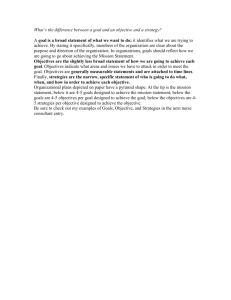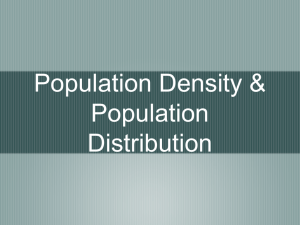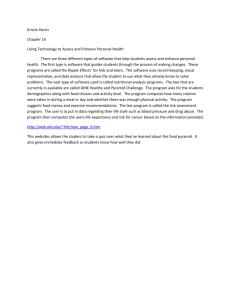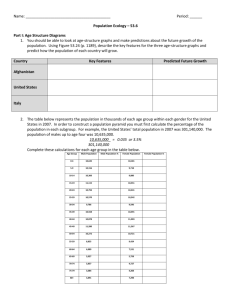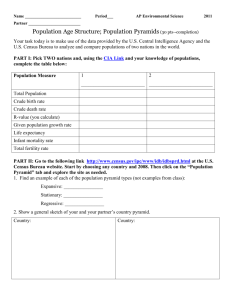Population Studies_Updated
advertisement
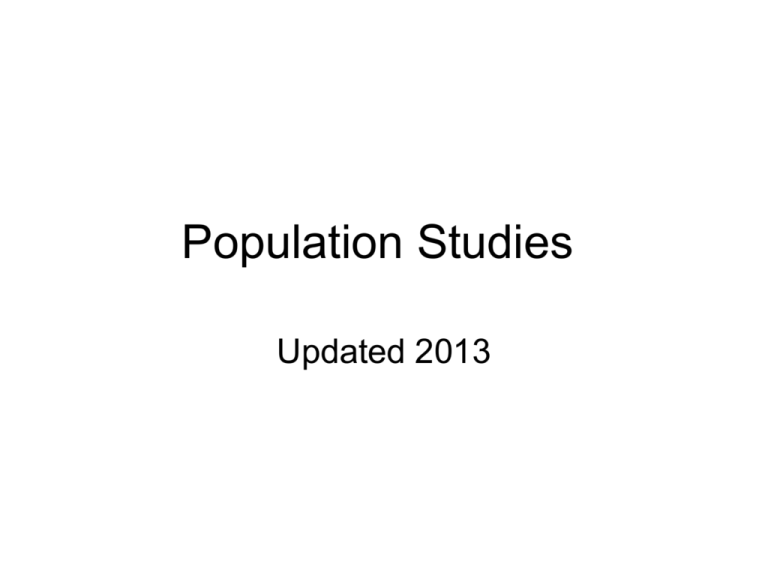
Population Studies Updated 2013 Population Density Which photograph shows an area with high population density? Population Density = Total number of people per unit area of land Calculation of Population Density • Total residents in 1997 = 3736700 • Total land area = 647.8 sq km Pop density = 5768 persons per sq km Population Density • Canada – 3 people per sq km • Bangladesh – 1042 people per sq km • Singapore – 6000 people per sq km http://www.photius.com/wfb1999/rankings/population_density_2.html Top 10 most densely populated countries and territories (humans/sq km) 1. 2. 3. 4. 5. 6. 7. 8. 9. 10. Monaco Macau Singapore Hong Kong Gibraltar Vatican City Malta Maldives Bermuda Bahrain 16818 16341 6652 6427 4308 1873 1277 1264 1248 1080 Source: The Straits Times (11 Jul 2008) Population Distribution • The way people are spread out over an area of land www.countrywatch.com/facts/facts_default.aspx... Factors Affecting Population Distribution 1. Physical Environment • Examples can include: – Relief – Climate – Soils 2. Level of technology • Las Vegas Population Distribution of Malaysia • Population is not evenly distributed • 80% of the people live on the west coast; 20% on the east coast. • Areas of high pop density are the major cities such as Kuala Lumpur, Melaka and Johor Bahru • Areas of low to moderate pop density are found on the coastal plain on the east coast Relief • Lowland areas/low reliefs are able to support a dense population • Development of settlements, transport, agriculture and industry • Central northern part is sparsely populated because it is mountainous Climate • West coast more densely populated – sheltered from SW monsoon by Sumatra • Sheltered from heavy rain facilitates the growth of trade, market towns and ports • East coast is exposed to NE monsoon as it faces South China Sea • Heavy and prolonged downpour causes floods and inflict economic losses Soil • Soil on the west coast is generally suitable for growing cash crops such as rubber and oil palm • Moist and soft soil also supports wet rice cultivation • Hence, west coast able to support dense population • East coast – swampy lowland • Mountains in central northern part – poor, thin, stony soil. Unsuitable for rice cultivation Describe and account for the population distribution and density in Peninsular Malaysia. Describe •High population density – where? •moderate population density – where? •Low population density – where? Account - Factors influencing population distribution •Physical environment •Level of technology High Population Growth in Developing Countries Population Pyramid • Shows the proportion of males and females in different age groups • Measured in % or no of total pop • Shape determined by BR, DR and migration How to look at a population pyramid? • Look at 4 things: – Overall shape – Narrow or Broad Base (% of population that is young) – Narrow or Broad Top (% of population that is old) – Skewness of gender ratio (has migration caused males/females to move out of the country?) A Pyramidal-shaped Population Pyramid (Progressive) Describing and interpreting • Broad base indicates high BR or fertility rate and an expanding/youthful population • Large dependent population account 35% or more of the total population • Pyramid narrows from age group to age group, indicating high DR • The narrow top from the 65 – 69 age group indicates low life expectancy • Overall sex ratio is balanced which reflects little immigration or emigration • Such a population diagram is typical of developing countries with increasing population Reasons for high growth rate: Developing countries Low DR High BR Better hygiene Lack of family planning Better nutrition Early marriages Better healthcare Preference for sons Need for farm labour High growth rate: Developing countries Consequences: Overpopulation •Strain on country’s resources (food, housing, education) •High unemployment rate •Environmental problems Responses for high growth rate: Developing countries Solutions •Education on family planning •Incentives and penalties through policies – China’s one child policy – Singapore’s “stop at two” policy Low Population Growth in Developed Countries A bee-hived Pyramid (Regressive) Describing and Interpreting • Narrow base indicates low BR and fertility rate • Young dependent makes up less than 30% of the total population • Broader top indicates a long life expectancy and a relatively low DR • Aged can account more than 15% of the population – greying pop • There is a possibility of the population shrinking as birth and population growth rates continue to drop each year • Such a pyramid typifies the population structure of developed countries Reasons for low growth rate: Developed countries Low DR Low BR Better hygiene Later marriages Better nutrition Fewer marriages Better medical and health care Preference for smaller families Consequences of low growth rate: •Aging Population –Lower economic output lower standard of living •Higher taxes on the smaller working population –More $$ is needed for public services like hospitals and libraries •Smaller talent pool & less dynamic workforce –Results in manpower shortages in creative or hightechnology sectors Measures to overcome low growth rate: • Incentives to encourage marriage and child bearing • Meeting needs of the elderly • Raising retirement age • Increasing population through immigration Case Study: Sweden Population Pyramid at 31 Dec 2006 http://www.scb.se/templates/tableOrChart____159280.asp See Link: Population Pyramid 1850 2050 References 1. Chong, M. (2000) Aspect of Human Geography, Singapore: Pekoe Books. Chapter 1 (p.1 – 47) 2. Waugh, D. (2000) Geography An Integrated Approach, UK: Nelson. Chapter 13 (p. 344 – 383) 3. Wikipedia
